Pennsylvania’s statewide Mentored Youth Trout Day to take place on Saturday, March 29, 2025, from 8 a.m. to 7:30 p.m.
By Steven Brodsky
From a news release that was issued today, March 26, 2025, by the Pennsylvania Fish and Boat Commission (PFBC):
Statewide Mentored Youth Trout Day is Saturday, March 29!
HARRISBURG, Pa. (March 26) – The Pennsylvania Fish and Boat Commission (PFBC) reminds anglers that Mentored Youth Trout Day will happen on Saturday, March 29, 2025, from 8 a.m. to 7:30 p.m. This is a statewide event open to youth anglers ages 15 and under and their licensed adult mentors on hundreds of waters in all 67 counties.
“This is a special day where our youngest anglers have a chance to have fun and learn fishing skills they can carry with them for a lifetime,” said Richard Kauffman, PFBC District 8 Commissioner.
The purpose of Mentored Youth Trout Day, created in 2013, is to provide an opportunity for young anglers to have fun while learning fishing skills a week before the large crowds arrive for the busy Statewide Opening Day of Trout Season on April 5.
“On this special day, the focus of every adult mentor should be on helping kids to fish, including teaching them how to bait a hook, cast a line, and hopefully, help them to safely reel in a few trout.” added Kauffman. “Remember, mentoring is most effective when just one adult accompanies each child, and the main goal should be to provide a positive experience for the kids, so they’ll want to keep fishing for many seasons to come.”
Before participating in Mentored Youth Trout Day, anglers should become familiar with fishing regulations and review the following information:
Find Stocked Trout Waters
While PFBC pre-season trout stocking is well underway in advance of the statewide Opening Day of Trout Season on April 5, not all waters will be stocked with trout prior to Mentored Youth Trout Fishing Day on March 29. To ensure an enjoyable experience and locate waters that have already been stocked, please review the 2025 Trout Stocking Schedule on the PFBC website (Fishandboat.com).
Who Can Participate?
Youth anglers require either a Voluntary Youth Fishing License ($2.97) or Mentored Youth Permit (free) and must be accompanied by a licensed adult mentor (age 16+) to participate. With their License or Permit, youth anglers can keep a total of two trout (combined species) with a minimum length of 7 inches.
Adult mentors (age16+) require a valid Pennsylvania Fishing License and a current Trout Permit. To participate in Mentored Youth Trout Day, anglers ages 16 and older must be accompanied by an eligible holder of a Mentored Youth Fishing Permit or a Voluntary Youth Fishing License. While adult mentors are permitted to fish while in the act of assisting a youth angler, adult anglers are prohibited from possessing trout.
Mentored Youth Trout Day is not intended for large groups of youth fishing with minimal adult supervision.
Get Your Licenses and Permits
Permits and licenses are available using the HuntFishPA online portal and in-person at nearly 700 license issuing agents. All anglers, including youth, are required to have their own account within the licensing system, which can be created either online or at a retail license issuing location. Upon creation of an account, anglers are issued a permanent, individual Customer Identification Number (CID#) that can be used for an improved, user-friendly experience during future transactions.
Why Buy a Voluntary Youth Fishing License?
The PFBC is a user-funded agency which receives no PA General Fund tax revenue to support its programs, including world-class trout stocking operations. For each Voluntary Youth Fishing License purchased for $2.97, the PFBC receives approximately $5 in funding as a federal reimbursement. These funds are dedicated for use only in youth outreach and education programs. The PFBC does not receive any funding to support programs through the issuing of free Mentored Youth Trout Permits.
Fishing from a Boat?
Anglers who plan to fish from a boat on Mentored Youth Trout Day and Opening Day of Trout Season are reminded that the PFBC’s cold weather life jacket requirement is in effect from November 1 through April 30. Under this rule, anyone aboard a boat 16 feet or less, including all canoes and kayaks, is required to wear a life jacket. Children ages 12 and under are always required to wear a life jacket while boating in Pennsylvania.
Prepare for Fun!
Whether you’re fishing for trout or any other species of fish this season, take advantage of the PFBC’s online maps to find great places to fish, learn about different types of fishing such as fly fishing and ice fishing, and review catch-and-release techniques for handling fish on the Get Started Fishing page on the PFBC website.
Posted 3-26-25
Public access restrictions at Middle Creek Wildlife Management Area that were set in place because of concerns about highly pathogenic avian influenza (HPAI) have been lifted
By Steven Brodsky
… An announcement appeared here about public access restrictions that were set in place on February 4, 2025.
Those restrictions have been lifted.
The Pennsylvania Game Commission issued this news release on March 7, 2025:
MIDDLE CREEK TO LIFT ACCESS RESTRICTIONS
Beginning Saturday, March 8, visitors to Middle Creek Wildlife Management Area again will have regular access to the property.
The Game Commission in early February closed public access to several locations at Middle Creek, including the popular wildlife-viewing area Willow Point, due to concerns about highly pathogenic avian influenza (HPAI), which at the time was being detected in increasing numbers of wildlife species and locations statewide.
The HPAI outbreak is ongoing nationwide, and the Game Commission continues to respond to reports and detect new cases in wild birds across the Commonwealth. However, there have been no mass mortality events in Pennsylvania approaching the scale seen in early January, when upward of 5,000 dead snow geese were removed from two sites in the Lehigh Valley. With limited HPAI reports and detections occurring within Middle Creek and its immediate surroundings, the Game Commission is comfortable lifting the access restriction previously put in place.
Visitors to the site, and Pennsylvanians everywhere, are advised to:
-
Always view wildlife from a safe distance
-
Avoid wildlife feces, and
-
Never handle sick or dead wildlife
Sick or dead wild birds, or any wild animal behaving abnormally or causing concern, should be reported to the Game Commission at 1-833-PGC-WILD (1-833-742-9453).
The Pennsylvania Department of Agriculture continues to advise domestic bird and poultry owners to maintain heightened biosecurity and, if possible, keep poultry indoors to safeguard their health. Any questions regarding domestic animals should be directed to the Department of Agriculture at 717-772-2852.
Those with questions about visiting Middle Creek can call the Visitor Center at 717-733-1512.
The Wildlife Drive, which is closed seasonally and remained closed in recent weeks, will reopen on Saturday, as well. Visitors are reminded that certain areas of Middle Creek are regularly closed to the public throughout the year to prevent disturbance of wildlife. and remain closed. Please adhere to posted signs indicating these areas.
Posted 3-12-25
The Pennsylvania Game Commission supports the reintroduced Pennsylvania Senate Bill 67; Senate Bill 67 ‘would end the state’s prohibition on Sunday hunting and allow the Game Commission to include Sundays when establishing hunting seasons annually.’
By Steven Brodsky
The Pennsylvania Game Commission issued this news release yesterday, March 6, 2025:
GAME COMMISSION APPLAUDS SUNDAY HUNTING BILL
Legislation that could fully repeal Pennsylvania’s Sunday hunting ban has been reintroduced in Harrisburg.
Sen. Dan Laughlin, R-Erie, this week reintroduced Senate Bill 67, which would end the state’s prohibition on Sunday hunting and allow the Game Commission to include Sundays when establishing hunting seasons annually. The bill picked up momentum last year, when it passed the Senate and gained preliminary approval in the House of Representatives before time ran out in the legislative session.
The bill now has a fresh start, and a broad base of support behind it. Many sportsmen’s groups back the initiative, as does the Pennsylvania Farm Bureau. The Game Commission looks forward to working with this coalition to get the bill across the finish line, an outcome that would benefit hunters and help ensure the future of wildlife management.
Game Commission Executive Director Steve Smith expressed the agency’s support for the proposal.
“Hunting takes time, and a lack of time is one of the biggest reasons cited by hunters who stop hunting,” Smith said. “Repealing the Sunday hunting ban and allowing the Game Commission to fully regulate Sunday hunting is an opportunity to provide hunters more time, which will help keep them engaged and carrying out their vital role in managing key wildlife populations. This legislation is beneficial to hunting’s future and the future of wildlife management in the Commonwealth. We support it, and thank Senator Laughlin for again championing this important issue.”
Posted 3-7-25
Winter will end this month in the Northern Hemisphere
By Steven Brodsky
… and most of this column’s readers are looking forward to the arrival of spring, a season with weather that’s generally more conducive to enjoying activities in the great outdoors.
When and where those activities (camping, fishing, etc.) will take place at night (especially in the absence of ambient light), children and adults can contemplate with awe, Psalm 8:3-5: “When I consider thy heavens, the work of thy fingers, the moon and the stars, which thou hast ordained; What is man, that thou art mindful of him? and the son of man, that thou visitest him? For thou hast made him a little lower than the angels, and hast crowned him with glory and honour.”
Posted 3-3-25
Some of the best bird photos
By Steven Brodsky
… that birders contributed to the Cornell Lab of Ornithology’s Macaulay Library archive in 2024 are accessible for you to view online.
Enjoy: https://www.allaboutbirds.org/news/macaulay-librarys-best-bird-photos-2024/.
Posted 1-13-25
At the right time and right place
By Steven Brodsky
… a gentle encounter with an element of winter can be serendipitous.
On the first evening of winter 2025, this poem by Robert Frost reminds us of this: Dust of Snow by Robert Frost | Poetry Foundation.
Similar (and surprising) beneficial encounters await many of us this season.
Enjoy winter 2025!
Posted 1-1-25
It wasn’t you, nor was it me
By Steven Brodsky
… who made this tree:
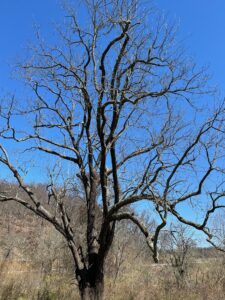
Photo by Steven Brodsky
“Trees,” by Joyce Kilmer: https://www.poetryfoundation.org/poetrymagazine/poems/12744/trees
The tree was photographed yesterday.
The Joyce Kilmer poem was published in August 1915.
This post originally appeared at: Conversations About Faith – delcoculturevultures.com.
Posted 3-25-24, Reposted and Revised 11-21-24
In a proper season
By Steven Brodsky
… appeared this frog (and the shadow it cast upon a lotus leaf):
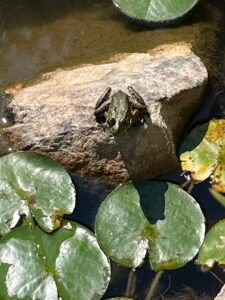
Photo by Steven Brodsky
Ecclesiastes 3 KJV (biblehub.com)
This post appeared in the Conversations About Faith section of this column.
Posted 4-25-24, Reposted and Revised 8-14-24
Exquisite is the monarch butterfly chrysalis stage
By Steven Brodsky
… as pictured here:
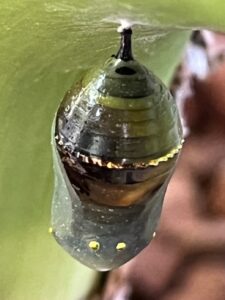
Photo by Steven Brodsky
I can’t say that I find the adult stage of the monarch butterfly to be more exquisite than the monarch chrysalis stage.
Which stage is more exquisite?
Not an easy question (for me) to answer.
It’s easier to simply enjoy seeing these two life stages of the monarch butterfly in the great outdoors!
Posted 8-7-24
Coming into the peace of some wild things
By Steven Brodsky
… with this photo and “The Peace of Wild Things”:
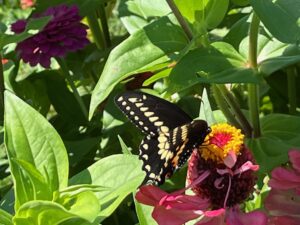
Photo by Steven Brodsky
Posted 7-9-24
‘Nature rarer uses yellow’
By Steven Brodsky
… wrote Emily Dickinson: https://www.online-literature.com/dickinson/poems-series-2/106/.
Thought of the poem today when this early spring spattering of translucent yellow came into view trailside in a National Park:
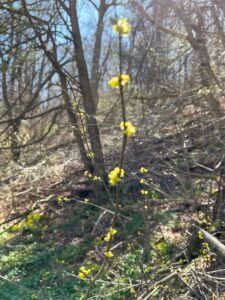
Photo by Steven Brodsky
Some of this column’s readers will recall the Emily Dickinson poem the next time that they take notice of nature’s yellow in the great outdoors.
Posted 3-24-24
A tarantula species was named after Johnny Cash 8 years ago, on February 5, 2016
By Steven Brodsky
… The species is found near Folsom State Prison, the venue where Johnny Cash’s first live album, Johnny Cash at Folsom Prison, was recorded on January 13, 1968. The album was released on May 6, 1968.
Folsom State Prison is located in Folsom, California.
The tarantula species is named Aphonopelma johnnycashi: http://www.sci-news.com/biology/aphonopelma-johnnycashi-new-tarantula-species-johnny-cash-03615.html.
Posted 2-5-24
Most people can relate
By Steven Brodsky
… to the kind of death that was experienced by the character in Seamus Heaney’s poem “Death of a Naturalist.”
Posted 7-12-22
A Conversation With Katie Fallon, Author of ‘Vulture: The Private Life of an Unloved Bird’
By Steven Brodsky
Katie Fallon is a co-founder of the Avian Conservation Center of Appalachia. She’s worked with many species of raptors and other kinds of birds. Katie’s books include Cerulean Blues (2011) and the recently released Vulture: The Private Life of an Unloved Bird. Her essays have appeared in a number of literary journals. She has a lifelong love of nature. I’ve heard that the first word she ever spoke was “bird.”
Your new book gives vultures, particularly turkey vultures, the positive attention these non-predator raptors deserve. What brought about your interest in these maligned birds?
I’ve been fascinated by vultures for at least fifteen years. There was a roost near where I lived in West Virginia; every day I’d drive by this big, old dead tree with ten or so turkey vultures hunched in it. They became a familiar sight, and I looked forward to seeing them. Vultures are big and kind of dramatic, and in flight, there’s nothing more beautiful. In addition, they’re the ultimate recyclers—they turn death into life.
Many people in the U.S. have an aversion to vultures. Speak about this.
I think vultures remind people of their own mortality. It can be a little creepy to think about a large, dark bird waiting to consume your body when you die. In general, I don’t think people in the US are comfortable with thinking of our bodies as food. Vultures remind us that life will continue after we die, and that some life will continue because we die. They remind us of our animal bodies. Which can be unnerving!
In the absence of vultures, we’d have major health issues to contend with. Tell us why.
Vultures clean up our ecosystems by removing animal carcasses that could potentially contaminate soil and water. They can eat animals that have died of anthrax and botulism. In the absence of vultures, mammalian scavengers could increase in number, and many mammalian scavengers such as raccoons, skunks, feral dogs and cats can spread rabies; vultures do not. Several vulture species in India have suffered catastrophic population crashes in the last twenty years, and public health has suffered. India leads the world in human rabies cases, and the number of cases has increased as the number of feral dogs increased in the absence of vultures.
People get close to vultures by attending your presentations that feature non-releasable birds. How are these birds acquired? How are they trained?
The nonprofit I co-founded, the Avian Conservation Center of Appalachia, keeps eight non-releasable raptors for educational purposes (you need permits from the US Fish & Wildlife Service to do this, of course – the birds aren’t pets or personal property). All of our birds were injured wild birds that cannot return to the wild. We have three vultures. Lew the turkey vulture was hit by a car and suffered an injury to his shoulder that prevents flight. His “girlfriend,” Boris, was shot in the wing, and by the time she reached us the bone had already healed incorrectly. Our black vulture is Maverick, and he was hit by a car, which resulted in a shoulder injury that prevents adequate flight.
Our birds are all trained using positive reinforcement. We avoid negative reinforcement and punishment, and we try to empower the birds to have some control over their environments. We condition behaviors by offering food rewards when the birds perform the behaviors. Vultures (especially our black vulture!) learn quickly, and they are a lot of fun to work with.
What myths and misunderstandings about vultures do these presentations help to dispel?
People are surprised at how clean and charismatic the vultures are – and how beautiful they are up close, despite their featherless heads.
What vulture behaviors do people find to be most interesting?
People often ask if vultures throw up on us; our education vultures usually don’t (unless they get scared). Vultures also expel liquid waste on their legs and feet, probably to clean them as well as to keep cool. This often fascinates people as well.
Which species of vulture are found in Pennsylvania and neighboring states?
We have turkey vultures and black vultures. During the last Ice Age we may have had California condors, too, and possibly some other now-extinct vultures.
What has been learned about migration of these species?
Hawk Mountain has taken the lead on turkey vulture migration research. Dr. Keith Bildstein and his team have placed transmitters and wing tags on turkey vultures all over the Americas. They’ve learned that our eastern turkey vultures are partial migrants—some spend the winters in Florida, some on the New Jersey shore, some in Virginia, and in many places in between. Many western turkey vultures are complete migrants, leaving their breeding ranges in Canada and heading all the way to South America. And still others in the American southwest migrate into Central America and return. It’s fascinating how the different subspecies have different migratory strategies. Dr. Bildstein and his colleagues have ongoing research projects about turkey vulture migration, and are discovering more all the time.
Vultures have spectacular flying ability. What makes this possible?
Turkey vultures are very light – they have almost the same wingspan as a bald eagle but weigh less than half what an eagle weighs. Their wings are long and broad, and are made for soaring.
How high can they fly?
The Ruppell’s vulture holds the record for the highest-flying bird. Unfortunately for that individual, it was hit and killed by a jet flying over Africa at 37,000 feet.
Vulture: The Private Life of an Unloved Bird informs readers about lead toxicity in vultures. What is the extent of the problem? How do vultures ingest lead?
Vultures (and eagles, hawks, crows, ravens, and owls) can ingest small pieces of spent lead ammunition in animal carcasses or “gut piles” left by hunters. When someone shoots a white-tailed deer, for example, the deer is usually field-dressed, and many of the organs are left. This can be a delight for vultures and other scavengers! In ecosystems, scavengers often follow the big predators to clean up the leftovers; here, the same thing is happening—a human is the big predator, a gut pile is the leftover, and a vulture or eagle is the scavenger. However, if small lead fragments are still in the gut piles, avian scavengers can inadvertently ingest the lead and become sick. Lead toxicity from spent ammunition is the biggest obstacle in the way of California condor recovery.
The Avian Conservation Center of Appalachia provides rehabilitation for injured birds. What kind of care do vultures receive?
We’ve treated vultures with a wide variety of injuries and ailments—broken bones, head trauma, lead toxicity, soft tissue injuries. Every bird we admit receives an immediate comprehensive examination by an avian veterinarian, and is then treated as necessary with antibiotics, antifungals, anti-inflammatories, fluid therapy, or chelation therapy. They also receive orthopedic surgery if necessary. We do our best to get the birds back out in the wild if possible.
It must be very joyful to enable an injured bird to regain flight ability. Please tell us about a memorable release.
Two and a half years ago we released a female turkey vulture that had been shot with a shotgun—she had three pellets embedded in soft tissue. We had to leave the pellets in her body because removing them would cause damage. Once she was nursed back to health, we released her wearing a transmitter to track her movements. We learned that she travels to northern Georgia in the winters and comes back to West Virginia in the breeding season. We are thrilled that this vulture was able to return to the wild—and thrive!
Vulture watching is growing in popularity. Turkey vultures are very widespread. Where are some of the best places and times to observe them?
In many parts of the southeastern United States, you can see turkey vultures any day of the year in a variety of habitats. In the winter, vultures can be observed roosting together in and near many cities: in Virginia, check out Leesburg, Staunton, Radford, Pulaski, and Charlottesville; in West Virginia, many vultures can be observed migrating in the fall over Hanging Rock Tower in Monroe County and over Harper’s Ferry in the eastern panhandle. During the summer and fall, the overlook at Cooper’s Rock State Forest near Morgantown, WV, is a sure place to see turkey vultures. Hawk Mountain in Pennsylvania, of course, is an excellent place to watch turkey vultures and birds of prey during migration, especially in September and October.
What stimulated your interest in nature?
I’ve always been an outdoors person. I grew up in northeastern Pennsylvania, and I had horses as a kid. I spent a great deal of time with my horses, trail riding and competing, and when I got a bit older I often went hiking and camping with friends and family. One of my favorite childhood hiking spots was Ricketts Glen State Park—it’s filled with hemlock trees and many gorgeous waterfalls. It’s definitely worth checking out if you visit northeastern PA.
Was “bird” your first word?
Yes! My parents had bird feeders in their yard when I was a baby (well, they still do) and my mother says she used to hold me in front of the window to show me the birds at the feeder. One day, she said, “Look at the birds! Look at the birds outside.” And I nodded and said, “Bird.” I haven’t stopped talking about them since.
Katie Fallon’s website address is: www.katiefallon.com.
Posted 4-6-17, Reposted 10-29-19
